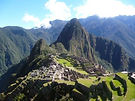PERU INFO
Home > About Peru > History > Pre-Inca Civilizations
About Peru
Pre-Inca Civilizations
Peru is not only the Incas. Which was the most famous South American civilization, only was developed during three centuries and the "Inca Empire" for less than a century.
Chronology of the major pre-Inca civilizations in Peru:
Caral – Supe
Between 3,000 and 1,600 BC.
It is located on the coast 200 km (124 mi) north of Lima. Caral is the first civilization in the Americas, consisting in a structured and organized society. Archaeologists little known about this culture currently under study, only it was a gentle, religious and agricultural civilization. The city of Caral is open to the public since 2006.
Tiahuanaco or Tiwanaku
Between 1,500 BC and 1,200 AD
It is the most important pre-Inca civilization of the Altiplano (highlands) in southern Peru, Bolivia and northern Chile. The most important archaeological remains found in the urban center and also religious capital, located on the Bolivian side 20 km (12 mi) south of Lake Titicaca. The Tiwanaku were specialized in high altitude agriculture (4,000 m / 13,000 ft a.s.l.), like the potato, quinoa, oca, etc. To deal with the extreme weather at this altitude, Tiahuanaku developed the "waru waru" ingenious high terraces fields surrounded by canals with two purposes:
prevent flooding and create a micro climate filling the canals with water that is heated by the sun during the day to return this heat at night and avoid freezing. The Tiwanaku also were great builders and their stone temples inspired the Incas that later would improve and perfect significantly their masonry.
Chavín
Between 1,000 and 200 BC.
Located on the coast and in the Andes, the Chavin civilization expanded its territory over 1,000 km (620 mi) from the present city of Chiclayo (780 km / 485 mi north of Lima) to Ica (300 km / 186 mi south of Lima). Its capital was Chavin de Huántar (3,180 m / 10,430 ft a.s.l.), located 100 km / 62 mi east of the city of Huaraz and 410 km / 255 mi north of Lima and was declared a World Heritage Site by UNESCO in 1985.
Paracas
Between 700 BC and 100 AC
This civilization of the Peruvian coast located south of Lima, is famous for its textiles with the finest and most beautiful fabrics of America. The Paracas were also known for practicing trephinations for medical purposes and skull deformation with an aesthetic purpose and to demonstrate social status.
Moche or Mochica
Between 300 BC and 800 AC
On the north coast, the Moche were considered the best potters of ancient Peru. Their ceramics with extraordinary realism represented divinities, men, animals, plants and scenes of life, including erotic figurines (huacos eróticos), the Peruvian kamasutra. The Moche were also excellent farmers, developing ingenious irrigation canals in the desert.
Their majors constructions were the impressive temples of Huaca del Sol and Huaca de la Luna (near the city of Trujillo). The Moche are also considered the precursors of surf over 3,000 years ago (before the inhabitants of the islands of the South Pacific and Hawaii), and even today one can appreciate fishermen gliding over the waves with their caballitos de totora (ponies of reeds). The Tomb of the Señor de Sipan, the most important archaeological discovery in the last 30 years (1987), dates from the Moche period.
Pucará
Between 100 BC and 300 AC
Established north of Lake Titicaca, the Pucara civilization started the domestication of the llama and alpaca and also the farming of height altitude, followed by the Tiahuanaku.
Nasca or Nazca
Between 100 and 650 AC
The three main features of this coastal civilization 450 km (280 mi) south of Lima, is the quality and finesse of their potteries, their ingenious irrigation canals in the desert and of course the famous and mysterious designs that can only be appreciated from a airplane. We don't know exactly the cause of the disappearance of this civilization, probably due to a very strong event "El Niño", which would completely affected the climate of the region causing devastating floods.
Lima
Between 100 and 700 AC
In the same period that the Nazca civilization, the Lima culture is characterized by the construction of huge pyramids that one can see in the capital, feather cloaks used by dignitaries and the ability of its people to catch deep-sea fish.
Wari or Huari
Between 600 and 1,200 AC
This culture was developed during the pinnacle of the Tiahuanaku civilization. Religious and warrior people, it is considered as the first empire in South America, expanding its territory from Cusco region to the north (1,500 km / 930 mi long), in the Andes and on the coast.
The capital is located near the present city of Ayacucho (560 km / 348 mi southeast of Lima). This civilization left us many important sites like Pikillacta (the city of fleas) near Cusco.
Lambayeque or Sicán
Between 700 and 1,400 AC
Northern coast of Peru (present city of Chiclayo) - With the disappearance of the Moche culture, probably due to a devastating phenomenon of "El Niño", the legendary King / God Naylamp emerges from the ocean to bring peace and prosperity in the region, carrying a stone representation of an idol, Yampayec (which gave the name to this civilization).
The Lambayeque or Sican civilization is known for its mastery in jewelry, highlighting the famous "Tumi", a ceremonial knife with the representation of the God Naylamp, which can be found in all handicraft markets and jewelers in the country. Later, the Incas also used the Tumi in religious ceremonies. The Lambayeque are also known for their ingenious irrigation systems and were prosperous farmers, mainly with corn and cotton.
This civilization has left large buildings in adobe (mud bricks) near the present city of Chiclayo, sites like Batan Grande, 17 pyramids of more than 30 m (100 ft) in height and Túcume with 26 pyramids and temples.
Chachapoyas
Between 800 and 1,475 AC
Limit Andes / jungle in northern Peru.
We know very little about the Chachapoyas or "warriors of the clouds" were ruled by the Inca Impire after long and difficult military campaigns.
Bearing a grudge against their invaders, regularly revolted and form part of these peoples allied to the Spaniards to defeat the Inca Empire.
This civilization left some great works, including the citadel of Kuelap, a gigantic fortress made of 400 buildings and surrounded by walls of 20 meters (65 ft) high.
Chimú
Between 1,100 and 1,400 AC
Located north coast of Peru. At the end of the reign of the Wari Empire, a small community of the Moche region (south of Trujillo - 560 km / 348 mi north of Lima) begins to develop. Quickly this people conquer vast territories mainly to the north, to create one of the greatest kingdoms of ancient Peru. Its capital Chan Chan, is the world's largest adobe city. The Chimu were conquered by the Incas in the fifteenth century.
This civilization is characterized by its mastery of intensive agriculture, ceramics and metallurgy.
Peru




